Roots Of Shotokan:
Funakoshi's Original 15 Kata
Part 3 - Seisan, Wanshu, Chinto, Jitte & Jion Kata
by Joe Swift
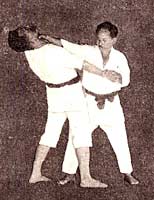
Editor's Note: This three part series examines
the roots of Shotokan karate through Gichin Funakoshi's 15 original
kata. The first
article discussed the controversy over Funakoshi's classification
of Okinawan karate's Shorin and Shorei traditions by body type, as well
as his knowledge of kata. The second
and third articles focus on in-depth discussions of the meaning and
origin of Funakoshi's core kata.
The Original Fifteen Kata of Shoto: The Last Five
Seisan (Hangetsu)
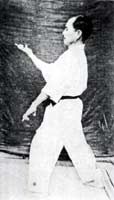 Meaning
13, some people refer to this kata as 13 hands, 13 fists, or 13 steps.
Customarily taught in both Tomari and Naha (towns on Okinawa), this
kata, following the tradition of Chotoku Kyan, is the first kata the
Isshinryu karate student learns. A move from Seisan is here demonstrated
by Funakoshi in his 1935 book.
Meaning
13, some people refer to this kata as 13 hands, 13 fists, or 13 steps.
Customarily taught in both Tomari and Naha (towns on Okinawa), this
kata, following the tradition of Chotoku Kyan, is the first kata the
Isshinryu karate student learns. A move from Seisan is here demonstrated
by Funakoshi in his 1935 book.
It is unclear exactly what the number 13 represents. Some think it
was the number of techniques in the original kata; some think it represents
13 different types of "power" or "energy" found
in the kata; some think it represents the number of different application
principles; some think it represents defending against 13 specific attacks;
and some think that it is the number if imaginary opponents one faces
while performing the kata. Out of all these theories, this author must
disagree with the last, as it is highly unrealistic that kata teaches
one to handle such situations. On the contrary, kata was designed to
teach the principles needed to survive more common self-defense situations,
rather than a long, drawn out battle against several opponents (Iwai,
1992).
Akio Kinjo, the noted Okinawan karate researcher and teacher who has
traveled to China, Hong Kong and Taiwan well over 100 times to train
and research the roots of Okinawan martial arts, maintains that this
kata originally had 13 techniques, but due to a long process of evolution,
more techniques were added to it (Kinjo, 1999). He also maintains that
the Okinawan Seisan kata derives from Yong Chun White Crane boxing from
Fujian Province in Southern China.
It is unsure who brought this kata to Okinawa, but we do know that
in 1867, Seisho Aragaki (1840-1920), a master of the Chinese-based fighting
traditions (Toudi) demonstrated this kata (among others) in front of
the last Sappushi (Chinese Imperial envoys), Xin Zhao (Tomoyori, 1992;
McCarthy, 1995, 1999).
The main lineages that include Seisan include those passed down from
Kosaku Matsumora /Kodatsu Iha /Chojo Oshiro, Chotoku Kyan, Seisho Aragaki,
Kanryo Higaonna, Kanbun Uechi, and Norisato Nakaima, among others. Shimabuku
learned this kata from Kyan. Both the Kyan and the Shimabuku versions
of this kata strongly resemble the "Matsumura no Seisan" used
in some sects of Shito-ryu (see Sakagami, 1978).
Noted senior Okinawan karate authority Hiroshi Kinjo (b. 1919) states
that there is no evidence of a Seisan kata being passed down in the
"Shuri" lineages of Sokon Matsumura and Anko Itosu, and that
the familiar "Shuri" lineage Seisan versions such as the Hangetsu
of Shotokan and the Seisan of Kyan lineage systems, should be referred
to as Tomari Seisan. His reasoning is that the so-called Oshiro Seisan
as presented in the 1930 "Kenpo Gaisetsu" by Nisaburo Miki
and Mizuho Takada was actually passed down from Kosaku Matsumora to
Kodatsu Iha to Kinjo's own teacher Chojo Oshiro of Yamaneryu Bojutsu
fame.
Kinjo believes that Funakoshi, being a school teacher in Tomari (the
small port town near Shuri, Okinawa's capital city), may have learned
same from Iha, and that as much of Kyan's tutelage seems to have come
from Tomari-based masters like Kosaku Matsumora and Kokan Oyadomari,
the Kyan version could also likely be traced to Tomari (Kinjo, 2001).
This is in direct contrast to many writings on the lineage of Kyan's
Seisan (see, for example, Bishop, 1999).
The "Master Seisan Theory," which claims that the kata was
brought from China to Okinawa by a Chinese martial artist named Seishan
(or Seisan), is uncorroborated myth at best, probably propagated by
well-meaning, but not-so-well-researched instructors. This legend cannot
be found in any of the literature coming out of Okinawa or Japan.
Wanhsu (Wansu or Enpi)
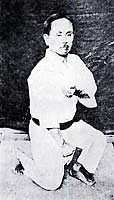 This
kata is said by many to have been brought to Okinawa by the 1683 Sappushi
(Chinese Imperial envoy) Ji Wang (Jpn. Oshu, 1621-1689). It is possible
that it is based upon or inspired by techniques that were taught by
Ji Wang. A move from this kata is here demonstrated by Funakoshi.
This
kata is said by many to have been brought to Okinawa by the 1683 Sappushi
(Chinese Imperial envoy) Ji Wang (Jpn. Oshu, 1621-1689). It is possible
that it is based upon or inspired by techniques that were taught by
Ji Wang. A move from this kata is here demonstrated by Funakoshi.
The problem with this theory is that why would such a high ranked government
official teach his martial arts (assuming he even knew any) to the Okinawans?
Also, Ji Wang was only in Okinawa for 6 months(Sakagami, 1978).
Ji Wang was originally from Xiuning in Anhui (a geographic section
of west central China), and was an official for the Han Lin Yuan, an
important government post (Kinjo, 1999). In order to become an official
for the Han Lin Yuan, one had to be a high level scholar, and pass several
national tests (Kinjo, 1999). Just preparing for such a position would
be such a time consuming task that is would all but rule out the practice
of martial arts. However, assuming that Ji Wang was familiar with the
martial arts, the Quanfa (a generic Chinese term referring to martial
arts) of Anhui is classified as Northern boxing, while the techniques
of the Okinawan Wansu kata are clearly Southern in nature (Kinjo, 1999).
So, was Wanshu named after Ji Wang, or someone else? This is as yet
unknown. However, in the Okinawan martial arts, kata named after their
originators are not uncommon. Some examples include Kusanku, Chatan
Yara no Sai, and Tokumine no Kon. It is entirely possible that this
kata was introduced by a Chinese martial artist named Wang (not the
offical Ji Wang). As the reader probably already knows, in the Chinese
martial arts, it is common to refer to a teacher as Shifu (lit. Teacher-father).
Could not the name Wansu be an Okinawan mispronunciation of Shifu Wang
(Kinjo, 1999)?
Other schools of thought are that Xianhui Wu (Jpn. Go Kenki, 1886-1940)
or Daiji Tang (Jpn. To Daiki, 1888-1937), two Chinese martial artists
who immigrated to Okinawa in the early part of the 20th Century, may
have been responsible for the introduction of the Wansu kata (Gima,
et al, 1986). As a side note, Wu was a Whooping Crane boxer and Tang
was known for his Tiger boxing. They were both from Fujian.
Chinto (Gankaku)
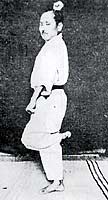 This
kata is said to have been taught to Sokon Matsumura (1829-1898. The
great Okianwan master) by a Chinese named Chinto, but this legend cannot
be corroborated. According to a 1914 newspaper article by Gichin Funakoshi
(1867-1957, founder of Shotokan karatedo), based upon the talks of his
teacher Anko Asato (1827-1906), student of Sokon Matsumura):
This
kata is said to have been taught to Sokon Matsumura (1829-1898. The
great Okianwan master) by a Chinese named Chinto, but this legend cannot
be corroborated. According to a 1914 newspaper article by Gichin Funakoshi
(1867-1957, founder of Shotokan karatedo), based upon the talks of his
teacher Anko Asato (1827-1906), student of Sokon Matsumura):
"Those who received instruction from a castaway from Annan in
Fuzhou, include: Gusukuma and Kanagusuku (Chinto), Matsumura and Oyadomari
(Chinte), Yamasato (Jiin) and Nakasato (Jitte), all of Tomari, who learned
the kata separately. The reason being that their teacher was in a hurry
to return to his home country." (sic, Shoto, 1914).
It is believed by this author that the "Matsumura" in the
above excerpt is a misspelling of Kosaku Matsumora, of Tomari. The fact
that Kosaku Matsumora is said to have taught Chinto to Chotoku Kyan,
is evidence that Matsumora may also have been taught this kata as well
(Kinjo, 1999).
Now, what exactly is Chinto? There is a form (kata) called Chen Tou
in Mandarin Chinese (Jpn. Chinto, lit. Sinking the Head) in Wu Zho Quan
(a.k.a. Ngo Cho Kuen, Five Ancestors Fist), which was a style popular
in the Quanzhou and Shamen (Amoy) districts of Fujian, or Fukien (Kinjo,
1999), the southern Chinese province facing modern day Taiwan, a popular
destination and departure point for both trade and immigration to an
from Okinawa before the 20th century.
Chen Tou refers to sinking the body and protecting the head. In the
Okinawan Chinto kata, this is the first technique, but in the Five Ancestors
Fist (style of kung fu) it is the last (Kinjo, 1999). However, that
being said, this author has never seen the Chen Tou form to make a comparative
analysis. It is, however, worthy of further investigation.
There are three distinct "families" of Chinto in modern Okinawan
karate: (1) Matsumura/Itosu lineage (performed front to back), (2) Kosaku
Matsumora lineage (performed side to side), and (3) the Chotoku Kyan
lineage (performed on a 45 degree angle). The version practiced by Funakoshi
is clearly from the Matsumura/Itosu lineage.
Jitte (Jitte)
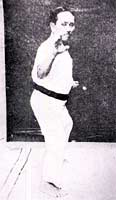 There
is very little in the way of written materials concerning the last two
kata on the list, namely Jitte and Jion. The earliest reference we see
to Jitte is in the 1914 article penned by Funakoshi (under his nom de
plume Shoto. He here demonstrates a move from this kata in his 1935
book) in the January 17-19 editions of the Ryukyu Shinpo newspaper,
where it is mentioned twice. In the section on the "kinds"
of karate (i.e. the kata), it is stated that Jitte is a kata that clearly
distinguishes the upper, middle and lower levels of technique (Shoto,
1914).
There
is very little in the way of written materials concerning the last two
kata on the list, namely Jitte and Jion. The earliest reference we see
to Jitte is in the 1914 article penned by Funakoshi (under his nom de
plume Shoto. He here demonstrates a move from this kata in his 1935
book) in the January 17-19 editions of the Ryukyu Shinpo newspaper,
where it is mentioned twice. In the section on the "kinds"
of karate (i.e. the kata), it is stated that Jitte is a kata that clearly
distinguishes the upper, middle and lower levels of technique (Shoto,
1914).
As already seen in the Chinto section of this article, Jitte is said
to have been taught by a Chinese castaway in the Tomari (the small seaport
town nearest Shuri, the capital of Okinawa) region. Chinto is said by
many to be related to Jion and Jiin kata (Iwai, 1992, Sakagami, 1978).
It is not known where Funakoshi may have learned the kata, but Anko
Itosu seems to be the best bet. In fact, Sakagami(the karate historian)
states that although Itosu modified many kata to fit his physical education
tradition, he seems to have left the Tomari kata of Jitte, Jion and
Jiin pretty much alone, thus hinting that Itosu did indeed teach versions
of these kata (Sakagami, 1978).
Although many of the applications of Jitte in the modern Shotokan world
seem to rely upon empty hand defenses against a stave-wielding attacker,
some believe that Jitte may actually be descended from a bojutsu kata
(Iwai, 1992). Unfortunately, neither can be proved with any satisfying
certainty. It is also interesting to note that in the book "Kenpo
Gaisetsu," there is a unique interpretation of this kata called
Itokazu no Jitte (Miki et al, 1930).
Jion (Jion)
Again, Jion is said to have some connection with Jitte and Jiin, but
exactly what that connection is, remains unclear and the object of intense
curiosity among karate researchers. First presented in Funakoshi's 1922
book "Ryukyu Kenpo Karate," another version of this kata was
also included in Nakasone Genwa's 1938 book "Karatedo Taikan,"
where it was performed by the legendary Chomo Hanashiro (1869-1945),
a student of Soken Matsumura and Anko Itosu, who assisted Itosu in his
teaching of karate to young people in the Okinwan school system.
With lack of reliable written resources about the origins of the kata,
we are left with naught but speculation. One researcher in Japan states
that Jion seems to have descended from a kata utilizing the Tekko, a
kind of Ryukyuan "knuckle duster." (Iwai, 1992)
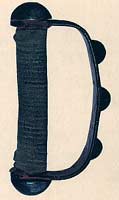 Tekko
were similar to western 'Brass Knuckles." Most often one was held
in each hand. In their traditional form (later models were often made
of molded brass or aluminum) Tekko had a grip (usually a round piece
of wood wound in rope) that was held in the palm of each fist. A rounded
studded metal piece then looped from each end of the grip to cover the
front of the fist (looking like a hand guard seen on many European swords).
They could be quite formidable weapons.
Tekko
were similar to western 'Brass Knuckles." Most often one was held
in each hand. In their traditional form (later models were often made
of molded brass or aluminum) Tekko had a grip (usually a round piece
of wood wound in rope) that was held in the palm of each fist. A rounded
studded metal piece then looped from each end of the grip to cover the
front of the fist (looking like a hand guard seen on many European swords).
They could be quite formidable weapons.
But alas, there is also no reliable evidence that these small, concealed
weapons of Ryukyu Kobudo were ever codified into formal kata before
Shinken Taira (a student Funakoshi and Mabuni in Japan, and Okinawan
weapons, or Kobudo under Moden Yabiki. He later formed the Ryukyu Kobudo
Hozon Shinkoku) came along. Another more plausible possibility is that
Shinken Taira may have been inspired by the Jion kata that he learned
from Funakoshi to create a formal kata for the Tekko (Nakamoto, 1983).
Jion seems to have been passed down to Funakoshi from Itosu, but if
it is indeed a kata passed down in the Tomari area, then it is also
possible that Funakoshi picked it up during his time as a school teacher
in that district. Jion is also the second standardized kata for JKF
competitions from the Shotokan lineage.
Reader Notes:
In Part
1 of this series, the classification, i.e. dividing Shorin-ryu
and Shorei-ryu by the body types of the practitioners, can be traced,
however, as far back as 1914, when Funakoshi penned an article on karate
for the Ryukyu Shinpo newspaper, based on the talks of his main teacher
Asato Anko, and writing under his pen name Shoto.
In Part
2 in the section on the Pinan kata, In their early, formative
years, these kata seem to have been called Channan, but later the name
Pinan was adopted by Itosu, apparently upon hearing the opinions of
the young students (Kinjo, 1956a; Mabuni et al, 1938; Murakami, 1991;
Swift, 2000).
For an overview of the Pinan/Channan controversy, see an article on
this subject on FightingArts.com: Channan:
The "Lost" Kata of Itosu?.
A note about Kanku Dai (the modern Shotokan version of the Itosu Kushanku
Dai kata) discussed in Part 2 of this series of articles. This kata
is one of two standardized Shotokan forms designated by the Japan Karatedo
Federation (JKF) for kata competitions.
In these articles reference to various Funakoshi books are: (1922)
refers to Ryukyu Kenpo Karate, (1925) refers to Rentan Goshin Karatejutsu,
and (1935) refers to Karatedo Kyohan.
The JKF has designated two kata from each of the "big four Japanese
styles" for their kata competitions. They are: Kanku Dai &
Jion from Shotokan, Seishan & Chinto from Wadoryu, Bassai Dai &
Seienchin from Shitoryu, and Saifa & Seipai from Gojuryu.
Bibliography
• Arakaki K. (2000) Okinawa Budo Karate no Gokui.
Tokyo: Fukushodo.
• Bishop, M. (1999) Okinawan Karate: Teachers,
Styles and Secret Techniques, 2nd Edition. Boston: Charles E. Tuttle.
• Fujiwara, R. (1990). Kakutogi no Rekishi.
Tokyo: Baseball Magazine.
• Funakoshi G. (1922) Ryukyu Kenpo Karate.
Tokyo: Bukyosha.
• Funakoshi G. (1925) Rentan Goshin Karatejutsu.
Tokyo: Okura Kobundo.
• Funakoshi G. (1935) Karatedo Kyoan. Tokyo:
Okura Kobundo.
• Funakoshi G. (1956) Karatedo Ichiro. Tokyo:
Sangyo Keizai Shinbunsha.
• Gima S. and Fujiwara R. (1986) Taidan:
Kindai Karatedo no Rekishi wo Kataru. Tokyo: Baseball Magazine.
• Hokama T. (1998) Okinawa Karatedo Kobudo
no Shinzui. Naha: Naha Shuppansha.
• Iwai T. (1992) Koden Ryukyu Karatejutsu.
Tokyo: Airyudo.
• Kinjo H. (1956) ìPinan no Kenkyu
Part 2,î Gekkan Karatedo. 1:3, July-August 1956. Tokyo: Karate
Jiho-sha.
• Kinjo A. (1999) Karate Den Shinroku. Naha:
Okinawa Tosho Center.
• Kinjo H. (1991b) Yomigaeru Dento Karate:
Kata I. Video Presentation. Tokyo: Quest Ltd.
• Kinjo H. (2001) Personal Interview. Kinjo
Residence, Hiratsuka, Japan, 30 June 2001.
• Mabuni K. and Nakasone G. (1938) Kobo
Kenpo Karatedo Nyumon. Tokyo: Keibunsha.
• McCarthy, P. (1999) Ancient Okinawan Martial
Arts: Koryu Uchinadi Vol. 2. Boston: C.E. Tuttle.
• McCarthy, P. (2001) Funakoshi Gichin &
Karatedo Tanpenshu. Brisbane: IRKRS.
• McKenna, M. (2000) "Jion: What You
See is Not What you Get." Journal of the Shotokan Research Society
International 2:2. http://user.netomia.com/srsi/
• Miki N. and Takada M. (1930) Kenpo Gaisetsu.
Tokyo: Tokyo Daigaku Kenpo-bu.
• Motobu C. (1926) Okinawa Kenpo Karate-jutsu:
Kumite-hen. Osaka: Karate Fukyukai.
• Motobu C. (1932) Watashi no Karate-jutsu.
Tokyo: Toudi Fukyukai.
• Murakami K. (1991) Karate no Kokoro to
Waza. Tokyo: Shin Jinbutsu Oraisha.
• Mutsu M. (1933) Karate Kenpo. Tokyo: Tokyo
Imperial University Karate Research Society.
• Nakamoto M. (1983) Okinawa Dento Kobudo:
Sono Rekishi to Tamashii. Okinawa: Bunbukan.
• Nakasone G. (1938) Karatedo Taikan. Tokyo:
Tokyo Tosho K.K.
• Sakagami R. (1978) Karatedo Kata Taikan.
Tokyo: Nichibosha.
• Shoto (1914) "Okinawa no Bugi Karate
ni Tsuite 1-3." Ryukyu Shinpo, January 17-19, 1914.
• Sofue T. (1997) "Bassai no Roots
wo Saguruî Gekkan Hiden," July 1999, Tokyo: BAB Japan.
• Swift, C. (2001) "Channan:
The Lost Kata of Itosu?" Dragon Times Issue #18.
This article also appeared on FightingArts.com.
About The Author:
Joe Swift, native of New York State (USA), has lived in Japan since
1994. He works as a translator/interpreter, and previously served
as an assistant instructor at the Mushinkan Okinawa Karate Kobudo
Dojo in Kanazawa. Swift now resides in Tokyo and will be opening a
a branch of the Mushinkan Dojo (Okinawa Shoreiryu) in that city. A
well know karate historian and researcher, Swift has published articles
in the Dragon Times and other leading martial arts journals and on
a variety of martial arts sites around the world. He is a Contributing
Editor for FightingArts.com.